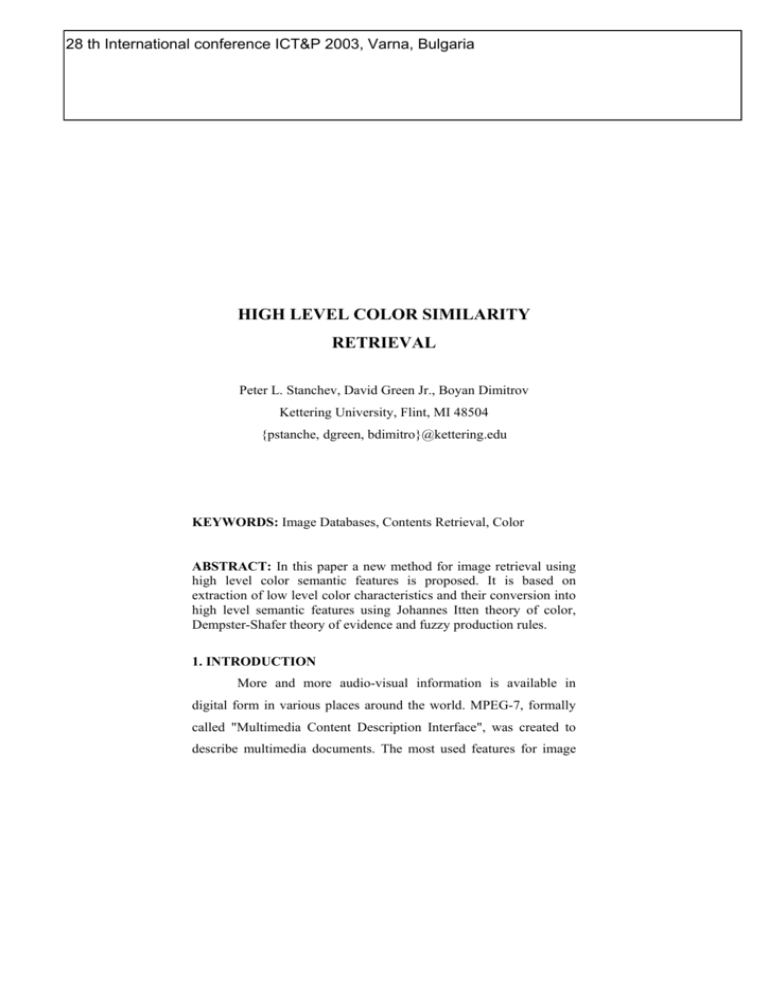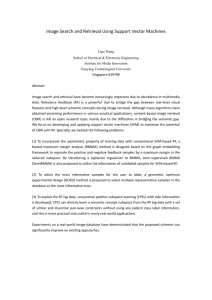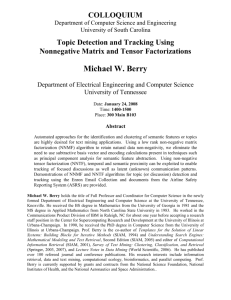high level color similarity retrieval
advertisement

28 th International conference ICT&P 2003, Varna, Bulgaria
HIGH LEVEL COLOR SIMILARITY
RETRIEVAL
Peter L. Stanchev, David Green Jr., Boyan Dimitrov
Kettering University, Flint, MI 48504
{pstanche, dgreen, bdimitro}@kettering.edu
KEYWORDS: Image Databases, Contents Retrieval, Color
ABSTRACT: In this paper a new method for image retrieval using
high level color semantic features is proposed. It is based on
extraction of low level color characteristics and their conversion into
high level semantic features using Johannes Itten theory of color,
Dempster-Shafer theory of evidence and fuzzy production rules.
1. INTRODUCTION
More and more audio-visual information is available in
digital form in various places around the world. MPEG-7, formally
called "Multimedia Content Description Interface", was created to
describe multimedia documents. The most used features for image
description is color. Many of the existing image databases allow
users to formulate queries by submitting an example image. The
system then identifies those stored images whose feature values
match those of the query most closely, and displays them. Color
features are usually represented as a histogram of intensity of the
pixel colors. Some systems, such as Color-WISE [10], partition the
image into blocks and each block is indexed by its dominant hue and
saturation values. Color and spatial distribution can be also captured
by an anglogram data structure [6].
High level image semantic representation techniques are
based on the idea of developing a model of each object to be
recognized and identifying image regions which might contain
examples of the image objects. One early system aimed at tackling
this problem is GRIM_DBMS [9]. The system analyzed object
drawings, and use grammar structures to derive likely interpretations
of the scene. The concept of the semantic visual template is
introduced by Chang et al [3]. The user is asked to identify a possible
range of color, texture, shape or motion parameters to express his or
her query, which is then refined using relevant feedback techniques.
When the user is satisfied, the query is given a semantic label (such
as “sunset”) and stored in a query database for later use. The use of
the subjective characteristics of color (such as warm or cold) to allow
retrieval of images is described in [4].
There is a ‘‘semantic gap’’ between information that can be
derived automatically, at archiving time, and what is convenient for
usability at querying time. How we can search by painting stiles?
Some stiles descriptions follow. The work that distinguishes the
Baroque period is stylistically complex, even contradictory. In
general, the desire to evoke emotional states by appealing to the
senses, often in dramatic ways, underlies its manifestations. Some of
the qualities most frequently associated with the Baroque are
grandeur, sensuous richness, drama, vitality, movement, tension,
emotional exuberance, and a tendency to blur distinctions between
the various arts. The Cubist style emphasized the flat, twodimensional surface of the picture plane, rejecting the traditional
techniques of perspective, foreshortening, modeling, and refuting
time-honored theories of art as the imitation of nature. Cubist
painters were not bound to copying form, texture, color, and space;
instead, they presented a new reality in paintings that depicted
radically fragmented objects, whose several sides were seen
simultaneously.
In this paper a method for image retrieval, based on high
level color image semantic features is discuss. It is a generalization
of the method described in [11] and gives possibilities for retrieval
painting stiles by color contrast. The layout of the paper is as
follows. In section 2 we explain the image feature extraction
mechanism. In section 3 we describe image retrieval based on high
level color semantic features. In section 4 we detail our experiments,
and finally in section 5 the conclusions of this paper are formulated.
2. COLOR FEATURE EXTRACTION MECHANISM
In this section the color characteristics extraction technique
and transformation of low level color characteristics into high level
color features are presented.
2.1. Color characteristics extraction mechanism
Color characteristics are usually represented as a histogram
of intensity of the pixel colors. Based on a fixed partition of the
image, an image could be indexed by the color of the whole image
and a set of image sub regions. In our method the color feature
extraction procedure includes color image segmentation. For this
purpose ideas from the procedure described in [4] are adopted. Fist
the standard RGB image is converted as L*u*v* (extended
chromaticity) image, where L* is luminance, u* is redness–
greenness, and v* is approximately blueness–yellowness [2]. Twelve
hues are used as fundamental colors. There are yellow, red, blue,
orange, green, purple, and six colors obtained as linear combinations
of them. Five levels of luminance and three levels of saturation are
identified. As a result every color is transferred into one of 180
references colors. After that, clustering in the three dimensional
feature spaces is performed using the K-means algorithm [8]. After
this step the image is segmented as N regions, and each is presented
in extended chromaticity space.
2.2. Low level color characteristics translation into high level
color semantic features
The purpose of this phase is to compose more complex
image semantic interpretation from those derived through the lowlevel image analysis characteristics. It is accomplished by applying
methods for extracting high level features and recursively applied
production rules from a set defined for the correspondent application
domain. The rules are defining also the degree of recognition (RD)
of a high level semantic feature as a distance among characteristics
implied in the rule and those found in the image. RD is calculated
with the help of fuzzy measures. An interference mechanism based
on backward chaining tries to derive from the low level
characteristics more general features and to give a recognition degree
to the features recognized.
In this phase a generalized inference mechanism is used.
After this step a sequence in the form (1) is obtained:
(1)
O1 1(m1 1, l1 1), ..., O1 S1(m1 S 1, l1 S 1), ... On 1(mn 1 , ln
1), ..., On Sn(mn S n, ln S n).
Such a sequence describes an image with n distinct high
level semantic features. The unit Oi j(mi j, li j) is a semantic
representation of the image feature i (i=1,2, … ,n) in the j-th (j=1,2,
…, sj) recognition. mi j and li j are respectively the RD and the list of
attributes of the i-th semantic feature in the j-th recognition.
To reduce the sequence (1) a procedure similar to Barnett's
scheme [1], based on the Dempster-Shafer theory of evidence [5] is
applied. The results obtained from applying the production rules are
converted into a list of new structures containing information for
each semantic feature:
(2)
O11([Bel(O11, 1-Bel(not O11)], l11), ..., O1q1([Bel(O1 q1,
1-Bel(not O1 q1)], l1 q1), ...,On1([Bel(On1, 1-Bel(not On1)],
ln1), ..., O q1([Bel(On qn, 1-Bel(not On qn)], ln qn),
where qi ≤ si (i=1, 2, ..., n).
The function Bel(Oij, 1-Bel(not Oij)] is a belief function. In
such sequences, features interpretations with low belief, according to
the user understanding are omitted. The belief function Bel(Oi)
(i=1,2, …,n) gives the total amount of belief committed to the
features Oi after all evidence bearing on Oi has been pooled. The
function Bel provides additional information about Oi, namely
Bel(not Oi), the extent to which the evidence supports the negation
of Oi, i.e. not Oij.
3.
RETRIEVAL
BASED
ON
HIGH
LEVEL
COLOR
SEMANTIC FEATURES
In this section we discuss image retrieval based on high level
color properties. It uses the theory formulated by Johannes Itten in
1961 [7]. In this theory color aesthetics may be approached from
impression (visually), expression (emotionally) and construction
(symbolically). Six different types of contrasts are identified:
1. Contrast of hue. It presents undiluted colors in their most
intense
luminosity.
yellow/red/blue,
Some
color
red/blue/green,
combinations
are:
blue/yellow/violet,
yellow/green/violet/red/, violet/green/blue/orange/black.
2. Light–dark contrast. It is based on comparison of day and
night, light and darkness. Rembrandt paintings are often
done with such contrast.
3. Warm–cold contrast. Colors or color combinations such as:
yellow, yellow-orange, orange, red-orange and red-violet are
referred as warm. Colors combinations like yellow-green,
green, blue-green, blue, blue-violet are referred as cold.
4. Complementary
contrast.
Two
colors
are
called
complementary if their pigments mixed together yield in
neutral grey. Examples are: yellow-violet, blue-orange, redgreen. This contrast gives the effect of a stability fixed
image.
5. Simultaneous contrast. It results from the fact that for any
given color the eye simultaneous requires the complement
color.
6. Contrast of saturation. Saturation relates to the degree of
purity of the color.
The used 180 colors in our method correspond to the colors in
the Runge-Itten sphere. The equators, horizontal and vertical views
of the sphere are given in Figure 1.
Figure 1. Three views of the Runge-Itten sphere
The color impression is connected with the color effects on
our sense of vision. The main color expression properties are the
following. Yellow color, the brightest and lightest color suggests
power and luminous. It symbolizes knowledge. With combination
with dark tones it presents cheerfulness. Red is the color of the
cardinals and it is associated with blood and it is always warm. Blue
color is always cold and shadowy, and it has retiring nature. Green is
the color of the vegetable, the spirit of early summer morning and
many different expressions can show by variations in green contrast.
Orange color gives radiant feelings. Violet is the color of
unconscious, mysterious, chaos, death. The color construction is
connected with the juxtapose of two or more colors in such way that
they jointly produce a distinct and distinctive expression. Production
rules are generated for different painting stiles.
4. THE EXPERIMENTS
The proposed method is a process of realization in a system
named “Flint”. In our experiments we use an image database
obtained with the help of Google image search engine.
For retrieval based on color features possible query could be:
“Find paintings with the following contrasts: Light-dark, cold-warm,
and simultaneous”. Parts of the retrieve painting are given in figures
2, 3 and 4.
Figure 2. Light-dark contrast: “Dr. Faustus in his study room”
sketching by Rembrandt and “Guitar on Mantelpiece” by Paulo
Picasso
Figure 3. Cold-warm-contrast in “Le Moulin de la Galette” by
Auguste Renoir, and “Houses of Parliament” by Clode Monet
Figure 4. Simultaneous contrast in “Stripping of Christ” by El Greco,
and “Café at Evening” by Vincent van Gogh
5. CONCLUSIONS
The main advantage of the proposed method is the
possibility of retrieval using high level color semantic features. After
the full system realization we will be able to obtain statistical
characteristics about the usefulness of the suggested method.
6. REFERENCES
[1]. Barnett J., Computational Methods for a Mathematical Theory of
Evidence, Proc. 7-th Inter. Joint Conf. on Artificial Intelligence,
Vancouver, BC, 1982, 868-875.
[2]. Carter, R., Carter, E., CIELUV color difference equations for selfluminous displays, Color Res. & Appl., 8(4), 1983, 252–553.
[3]. Chang, S., Chen W., Sundaram H., Semantic visual templates:
linking visual features to semantics, in IEEE International
Conference on Image Processing (ICIP’98), Chicago, Illinois,
1998, 531-535.
[4]. Corridoni, J, Bimbo A., Vicario E., Image retrieval by color
semantics with incomplete knowledge, Journal of the American
Society for Information Science 49(3), 1998, 267-282.
[5]. Gordon J., Shortliffe J., The Dempster-Shafer Theory of Evidence
in Rule-Based Expert Systems, in B. Buchanan, E. Shortliffe
(edt.), Mycin Experiments of the Stanford Heuristic Programming
Project, Addison-Wesley Publishing Company, 1984, 272-292.
[6]. Grosky W., Stanchev P., An Image Data Model, in Advances in
Visual Information Systems, Laurini, R. (edt.), Lecture Notes in
Computer Science 1929, 2000, 14-25. [m2]
[7]. Itten, J., The art of colors, Reinhold Publishing Corporation of
New York, 1961.
[8]. Jain, A., Algorithms for clustering data. Englewood Cliffs, NJ,
Prentice Hall, 1991.
[9]. Rabbitti, F and Stanchev, P., GRIM_DBMS: a graphical image
database management system, in Visual Database Systems, Kunii,
T. (edt.), Elsevier, Amsterdam, 1989, 415-430.
[10].
Sethi, I., Coman, I., Day, B., Jiang, F., Li, D., SegoviaJuarez, J., Wei, G., and You, B., Color-WISE: A System for
Image Similarity Retrieval Using Color, Proceedings of SPIE
Storage and Retrieval for Image and Video Databases, Volume
3312, February 1998, 140-149.
[11].
Stanchev P., Using Image Mining for Image Retrieval,
IASTED International Conference “Computer Science and
Technology”, May 19-21, 2003, Cancun, Mexico.








